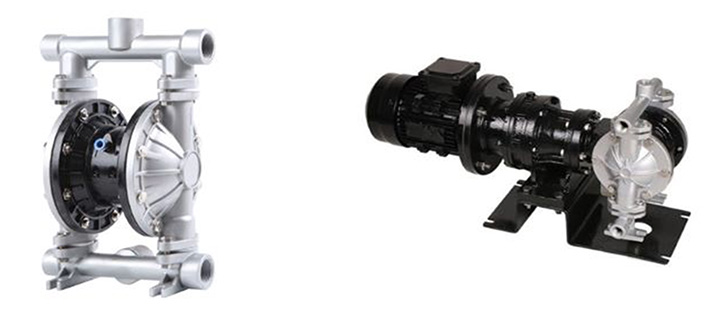What are the Advantages of Diaphragm Pump?
A diaphragm pump is a positive displacement pump that utilizes two flexible diaphragms that reciprocate back and forth to create a temporary chamber through which fluid is drawn in and expelled through the pump. The diaphragm acts as a separation wall between air and liquid, which can not only pump flowing liquid, but also transport some difficult-to-flow media. According to different working conditions, diaphragm pumps of different materials such as aluminum alloy, cast iron, and stainless steel can be selected to meet the needs of different users. In this article, we will introduce the advantages of diaphragm pumps.
Basic composition
Diaphragm pump, also known as control pump, changes the fluid flow by means of power operation by receiving the control signal output by the adjustment control unit. Pneumatic diaphragm pumps and electric diaphragm pumps are diaphragm pumps with two different driving modes. Their basic structures are similar, including pump body, diaphragm, air distribution valve, inlet and outlet valves and connectors.
The pump body is usually made of metal or engineering plastics to accommodate and support other component parts. Diaphragm is the core part of these two pumps. It is made of elastic materials such as rubber, VITON, and polytetrafluoroethylene (PTFE). It separates the inlet and outlet of the pump so that the media on both sides do not interfere with each other, and realizes reciprocating motion through the driving device to realize the suction and discharge of liquid. The gas distribution valve is used to control the gas or liquid supplied by the pneumatic drive device or electric drive device, change the pressure on both sides of the diaphragm, and drive the reciprocating movement of the diaphragm. The inlet and outlet valves are used to adjust the flow and pressure of the liquid to ensure that the pump has good control performance during work. Connectors are used to connect the pump body, diaphragm, driving device, valves and other components to ensure the stability of the pump assembly and operation.

Advantages
Long service life and easy maintenance. The diaphragm pump has superior durability, and its structure is simple and easy to maintain. The diaphragm pump has a strong self-priming function, which will not cause damage to the pump body or dangerous situations even after long periods of dry running or idling. In addition, the medium conveyed by the pump will not touch the moving parts such as the gas distribution valve and the connecting rod, which reduces the wear and tear of the parts, has few wearing parts, and is very convenient for installation and maintenance.
Small damage to the conveyed material. The diaphragm pump has no rotating parts, and basically does not cause agitation to the material. The method of sucking in and protruding the material is the same during operation, the liquid has no shear flow, the material has good passing performance, and has little damage to the material, so it can transport unstable and easily damaged materials.
Wide range of uses. The material selection and structural design of the diaphragm pump make it suitable for a wide range of material types. Whether it is granular media, viscous liquids, volatile, highly toxic liquids, or even various strong acids, alkalis and strong corrosive liquids, diaphragm pumps can easily complete the delivery task.
Safe and reliable. The diaphragm pump has no rotating parts, no shaft seal, the pumped medium such as the diaphragm is completely separated from the moving parts of the pump and the workpiece medium, and the transported medium will not leak outward. Therefore, when pumping toxic, volatile or corrosive media, it will not cause environmental pollution and endanger personal safety.
Easy to use and reliable. To start and stop, you only need to simply open and close the gas valve. The head and flow can be adjusted by the pressure of the gas source. Even if the pump runs without medium for a long time or stops suddenly due to accidents, it will not be damaged. Once overloaded, the pump will stop automatically.
Application
In the following, ATO automation will introduce you to several application fields of diaphragm pumps, hoping to let you know more about diaphragm pumps.
Chemical industry: Diaphragm pumps are widely used in the chemical industry to transport various chemicals, acids, alkalis, solvents, paints, pigments, resins and other corrosive media.
Petroleum and petrochemical industry: In the field of petroleum and petrochemical, diaphragm pumps are often used to transport crude oil, petroleum by-products, lubricating oil, petrochemical products, etc.
Food and beverage industry: Diaphragm pumps are used in the food and beverage industry to convey liquids such as food, beverages, dairy products, juices, and beer.
Pharmaceutical industry: In the pharmaceutical industry, diaphragm pumps are usually used to transport various liquid medicines, biological products, etc.
Environmental protection industry: In the field of environmental protection, diaphragm pumps can be used for pumping in the process of sewage and wastewater treatment, and are suitable for transporting various liquid medicines and waste liquids in sewage containing solid particles and high concentrations, so as to effectively treat and dispose of environmental pollutants.

